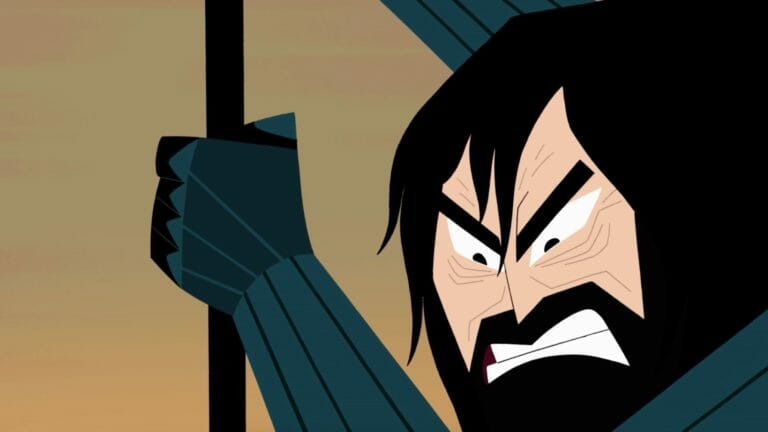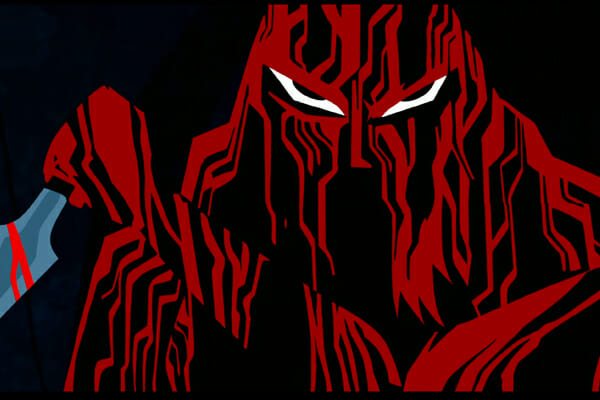Sign up for the
TSL Newsletter
and get $50 off Final Draft 12
By Caroline Cao · April 10, 2017

Following a decade-long hiatus, the critically acclaimed Samurai Jack has returned to television for a long-awaited fifth and final season – one that promises to conclude the titular samurai’s odyssey to return to his home in the past.
Genndy Tartakovsky’s Samurai Jack is most famous, perhaps, for its wordless sequences – Jack wandering in silence through grand vistas or locked in battles with bots, and demon shape-shifters. It makes sense, after all – in animation, storyboarding is as essential to the scripting process as the words themselves, which holds doubly true for show-don’t-tell theatrics of Tartakovsky’s team.
Recaps are par for the course for serialized television, usually delivered through clip reels and a brief bit of voiceover. Some are more creative than others – Cartoon Network productions like Steven Universe, for example, tend to use the narrative itself to relay previous plot points through visual and verbal exposition within the first few minutes of an episode. Sometimes it’s as easy-peasy as a “Remember that time…” line of dialogue combined with brief snippets from a previous event interwoven into the narrative. Just enough to bring the audience up to speed and provide them with the facts necessary for a new adventure.
Unfortunately for showrunners, it’s unrealistic to expect all viewers to be caught up on a show at all times. In fact, the very nature of “increased viewership” suggests that certain segments of an audience are boarding an already moving train. One might imagine this holds especially true for a show as visually gorgeous as Samurai Jack, which is likely to give pause to even the most cynical channel surfers unfamiliar with rogue adventures of a time-displaced samurai. And with its fifth season receiving such stellar reviews (a 94 on Metacritic), it’s likely that newcomers to the series are at an all time high.
The question is this: how do you bring audiences up to speed without bogging down the narrative? How do you color in the world, define its characters, and re-enforce past narrative beats that even long-time viewers might have forgotten, all within an all-to-brief 22 minutes? Like most complex problems, the simplest solution is generally the best one, and if Taratakovsky’s masterful, precise, and often playful grip on exposition in Samurai Jack is anything to go by, less is almost always more.

EPISODE XCII: In Media Res (or, starting in the middle of something)
Season 5’s premier opens on a battlefield with our heroic samurai rescuing two civilians, and then riding off. There’s little in the way of context beyond the sparse images on screen – even after a decade off the airwaves. In fact, no words are spoken at all until the title sequence delivers a brief monologue revealing that 50 years have passed since we last saw Jack, who, as it so happens, is still seeking a way to return to the past.
And yet, for long-time viewers, these opening visuals present just enough in the way of mysteries to intrigue and tantilize: Why is our hero riding a motorcycle and padded in heavy armor instead of his usual ghi tunic? Where is the samurai’s iconic magic sword? Considering Jack’s reputation for friendliness and amicability towards those he helps, why does he ride off so coldly without so much as a farewell? For new viewers, the question is an even simpler on: Who is this guy?

EPISODE XCIII: A Ridiculous, Flamboyant Scenario Filled With Essential Details
Exposition is almost universally uninteresting if not delivered with a certain amount of flair. A recent ScriptShadow piece on the Big Lebowski points this out:
“The bowling alley where our characters always meet up has NOTHING to do with the story. It’s merely there for expositional purposes. Technically, our characters could be discussing this stuff anywhere (a coffee shop, a workplace, a restaurant). Here’s why the Coens are clever though. They know if the location is random, the exposition will stick out like a sore thumb.”
When we first meet Samurai Jack’s arch-nemesis in Season 5, the shape-shifting demon Aku partakes in something altogether unexpected yet entirely plausible. In a sidesplitting sequence, we watch as our antagonist creates a double of himself, dressed in a psychiatrist outfit, and vents to him on a couch.
“So, what’s been bothering you?”
The therapeutic duality sets the stage for a conversation that not only re-introduces Aku, but also reminds the audience of the bizarre un-aging of Jack. It also establishes a crucial dramatic irony that was only hinted at in the previous episode: Aku is totally unaware that Jack has lost the magic sword that could defeat him. In this sense, the conversation serves as an essential bit of exposition, all of which delivered in a way that’s character-specific and conceptually refreshing.
All while provoking a laugh or two from viewers along the way.

EPISODE XCIV: Revealing the Inner Psyche – The Hero Converses With Himself
In this episode, Samurai Jack is granted a talk-to-your-self sequence, albeit with a slightly more dramatic twist. We watch as he converses with a ghoulish devilish – a manifestation of his samurai-self – mocking and reprimanding his current regression into un-samurai practices.
It repeats what transpired in the previous episode while centralizing Jack’s own psychological journey – in particular, the nasty shock of taking a life for the first time. In the previous 2001-2004 run, which appealed to a somewhat younger demographic, Jack slaughtered robots that bled oil instead of blood. Not so anymore.
Not unlike the classic Sméagol-Gollum trope, Jack grapples with the good, the bad, and grey of his predicament, all the while his conscience gloats, like a devil on his shoulder, “You’ll have to kill them too!” referring to the remaining assassins still in pursuit. The conversation frames the episode’s self-contained narrative of Jack coming to terms with the sometimes fatal consequences of self-preservation.
With visionaries like Tartakovsky and his team, it should come as no surprise that each episode manages to use exposition as a tool to experiment with sharp imagery and clever ideas, all while weaving essential information through compelling character conflict.
Let’s see what they come up with next.
Caroline Cao is a Houstonian Earthling surviving under the fickle weather of Texas. When not angsting over her first poetry manuscript or a pilot screenplay about space samurais, she enjoys acting in cheesy improv performances for BETA Theater, experimenting with ramen noodles, and hollering vocal flash fics on Instagram. Her columns and poems have popped up on The Cougar, Mosaics: The Independent Women Anthology, Glass Mountain, OutLoud Culture, and Aletheia. Her flash fiction recently earned an Honorable Mention title in Sweater Weather magazine. She has her own blog and lends her voice to Birth.Movies.Death.